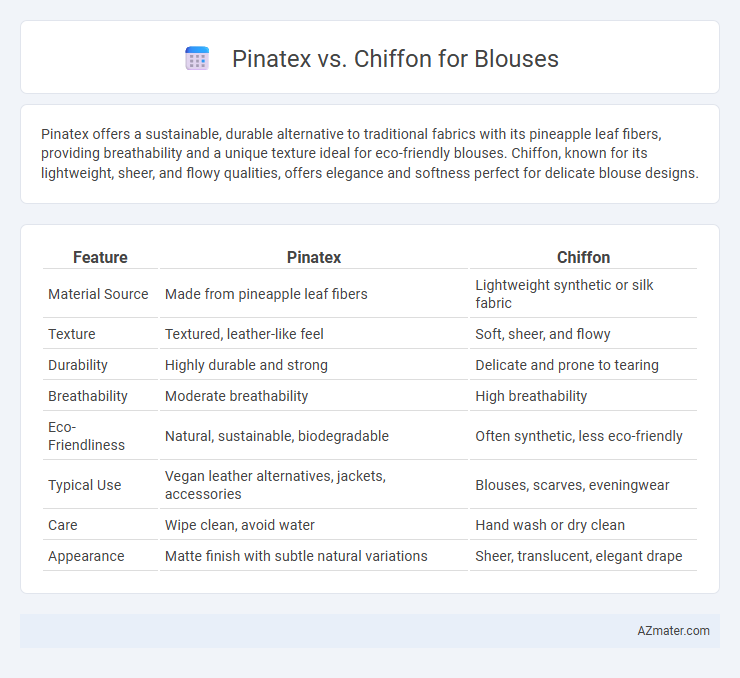Pinatex offers a sustainable, durable alternative to traditional fabrics with its pineapple leaf fibers, providing breathability and a unique texture ideal for eco-friendly blouses. Chiffon, known for its lightweight, sheer, and flowy qualities, offers elegance and softness perfect for delicate blouse designs.
Table of Comparison
| Feature | Pinatex | Chiffon |
|---|---|---|
| Material Source | Made from pineapple leaf fibers | Lightweight synthetic or silk fabric |
| Texture | Textured, leather-like feel | Soft, sheer, and flowy |
| Durability | Highly durable and strong | Delicate and prone to tearing |
| Breathability | Moderate breathability | High breathability |
| Eco-Friendliness | Natural, sustainable, biodegradable | Often synthetic, less eco-friendly |
| Typical Use | Vegan leather alternatives, jackets, accessories | Blouses, scarves, eveningwear |
| Care | Wipe clean, avoid water | Hand wash or dry clean |
| Appearance | Matte finish with subtle natural variations | Sheer, translucent, elegant drape |
Introduction to Piñatex and Chiffon Blouses
Pinatex is an innovative natural textile made from pineapple leaf fibers, offering a sustainable and eco-friendly alternative to traditional fabrics, known for its durability and unique texture. Chiffon, a lightweight, sheer fabric made from silk, nylon, or polyester, provides a soft, flowing appearance often favored for elegant and delicate blouses. Both materials bring distinct qualities to blouse design, with Pinatex appealing to eco-conscious consumers and chiffon catering to those seeking graceful, airy garments.
Material Origin and Composition
Pinatex is a sustainable fabric made from pineapple leaf fibers, offering an eco-friendly alternative with a natural texture ideal for blouses seeking a unique, plant-based origin. Chiffon consists of lightweight, sheer fabric typically crafted from silk, polyester, or nylon, emphasizing a smooth, delicate composition that drapes elegantly for refined blouse designs. Choosing Pinatex supports biodegradable material innovation, while chiffon provides versatility in blend options for softness and fluidity.
Environmental Impact: Piñatex vs Chiffon
Pinatex, made from sustainably sourced pineapple leaf fibers, significantly reduces agricultural waste and water consumption compared to traditional textiles. Chiffon, often produced from synthetic fibers like polyester, contributes to microplastic pollution and relies heavily on fossil fuels. Choosing Pinatex over chiffon lowers the environmental footprint by promoting biodegradable materials and minimizing synthetic waste in fashion production.
Texture and Comfort Comparison
Pinatex offers a unique, slightly coarse texture derived from pineapple leaf fibers, providing durability and an eco-friendly alternative to traditional fabrics, while chiffon is lightweight and sheer with a smooth, soft feel ideal for delicate, flowing blouses. Pinatex's firmness supports structured designs but may lack the breathability and drape chiffon provides, which enhances comfort in warm weather and allows for elegant movement. Choosing between Pinatex and chiffon depends on the desired balance between sustainability, texture, and the blouse's functional comfort.
Durability and Maintenance
Pinatex, made from pineapple leaf fibers, offers exceptional durability and resistance to wear, making it ideal for long-lasting blouses with minimal maintenance. Chiffon, a lightweight and delicate fabric usually crafted from silk or synthetic fibers, requires gentle handling and careful washing to maintain its appearance and prevent damage. Choosing Pinatex ensures a more robust garment suited for frequent use, while chiffon demands higher maintenance to preserve its soft texture and drape.
Style and Aesthetic Appeal
Pinatex offers a unique, textured look made from pineapple leaf fibers that adds an eco-friendly, artisanal touch to blouses, perfect for sustainable fashion enthusiasts seeking a modern statement. Chiffon provides a lightweight, sheer fabric renowned for its elegant drape and soft flow, making it ideal for creating delicate, feminine blouses with a timeless appeal. Choosing between Pinatex and chiffon depends on whether the desired aesthetic is bold and innovative or classic and graceful.
Breathability and Climate Suitability
Pinatex offers moderate breathability due to its natural pineapple leaf fibers, making it suitable for cooler climates or transitional seasons but less ideal for high heat and humidity. Chiffon, typically made from lightweight silk or polyester, provides excellent breathability and moisture-wicking properties, ideal for hot and humid climates. For blouses, chiffon ensures better airflow and comfort in warm weather, while Pinatex is more appropriate for structured garments in milder conditions.
Cost and Accessibility
Pinatex, made from pineapple leaf fibers, offers an eco-friendly and often more affordable alternative to traditional fabrics, with prices typically ranging from $15 to $25 per yard, making it accessible for sustainable fashion brands. Chiffon, a lightweight and sheer fabric usually crafted from silk or polyester, tends to be more expensive, with silk chiffon costing between $20 and $40 per yard and synthetic versions slightly cheaper but less breathable. Accessibility-wise, Pinatex is gaining momentum in ethical and artisanal markets but remains less widely available than chiffon, which is commonly found in mainstream fabric stores globally.
Suitability for Different Occasions
Pinatex, made from pineapple leaf fibers, offers a sustainable and durable option ideal for casual or eco-conscious events due to its textured, leather-like appearance. Chiffon provides a lightweight, sheer, and flowy fabric perfect for formal occasions such as weddings, parties, or elegant evening wear, thanks to its delicate drape and softness. Selecting between Pinatex and chiffon depends on the desired look and event formality, with Pinatex favoring structured, statement pieces and chiffon suited for graceful, ethereal blouses.
Final Verdict: Which Is Best for Blouses?
Pinatex offers sustainable, durable, and breathable qualities ideal for eco-conscious blouse consumers, while chiffon provides a lightweight, sheer, and elegant drape favored for formal and feminine styles. The choice depends on the desired aesthetic and functionality, with Pinatex excelling in textured, structured designs and chiffon preferred for airy, flowing silhouettes. For blouses prioritizing sustainability and resilience, Pinatex is best, whereas chiffon suits those seeking delicate softness and classic elegance.

Infographic: Piñatex vs Chiffon for Blouse
 azmater.com
azmater.com